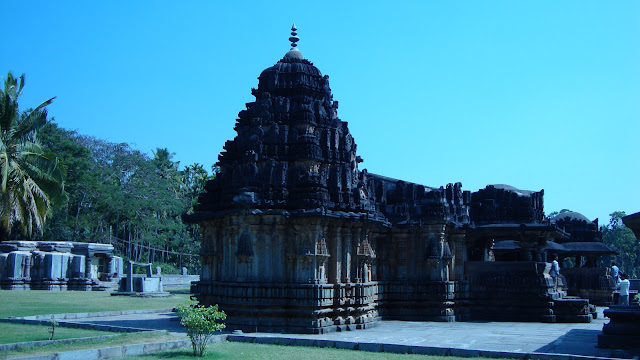Amrutesvara Temple, Amruthapura
Amruthapura is known for the splendid Amruteshvara temple (also often spelt Amruthesvara or Amrtesvara). The temple was built in 1196 C.E. by Amrutheshwara Dandanayaka commander under Hoysala King Veera Ballala II.
The temple is a fine example of 12th century Hoysala architecture with a wide open mantapa (hall). Surrounded by Palm and Coconut farms, the temple still has a well preserved original outer wall with interesting, equally spaced circular carvings. The temple has one vimana (shrine and tower) and therefore is a ekakuta design, and has a closed mantapa (hall) that connects the sanctum to the large open mantapa
It is medium sized Hoysala temple and compares closely with the Veera Narayana Temple, Belavadi in mandapa structure and size. The open mandapa has twenty nine bays, and the closed mantapa has nine bays with a side porch that leads to a separate shrine on the south side. The shrine is square in shape has the original superstructure (sikhara) which is richly adorned with sculptures of Kirthimukhas (demon faces), miniature decorative towers (aedicule). Below the superstructure, the usual panel of Hindu deities is absent. The base of the wall has five mouldings which according to art critic Foekema is an "older Hoysala style". The Sukanasi, the tower on top of the vestibule that connects the sanctum to the closed mantapa (the Sukanasi appears like the nose of the superstructure), has the original Hoysala emblem of "Sala" fighting the lion.
The rows of shining lathe turned pillars that support the ceiling of the mantapa is a Hoysala-Chalukya decorative idiom. The mantapa has many deeply domed inner ceiling structures adorned with floral designs. The outer parapet wall of the open mantapa has a total of hundred and forty panel sculptures with depictions from the Hindu epics. Unlike many Hoysala temples where the panels are small and carvings in miniature, these panels are comparatively larger. The Ramayana is sculpted on the south side wall on seventy panels, with the story proceeding quite unusually, in anti-clockwise direction. On the north side wall, all depictions are clockwise, a norm in Hoysala architectural articulation. Twenty five panels depict the life of the Hindu god Krishna and the remaining forty five panels depict scenes from the epic Mahabharata.
Ruvari Mallitamma, the famous sculptor and architect is known to have strated his career here working on the domed ceilings in the main mantapa. The large stone inscription near the porch is an excellent example of medieval Kannada poetry composed by the famous poet Janna
From Bangalore 245 kms
From DHQ Chikmagalur 70 kms
Route :
1.Bangalore-Tumkur-Tiptur-Arasikere-Kadur-Birur-Tarikere-Amruthapura.
2.Shimoga-Bhadravathi-Tarikere-Amruthapura.
3.Mysore-Holenarasipura-Hassan-Chikmagalur-Lingadahalli-Tarikere-Amruthapura.






























No comments:
Post a Comment